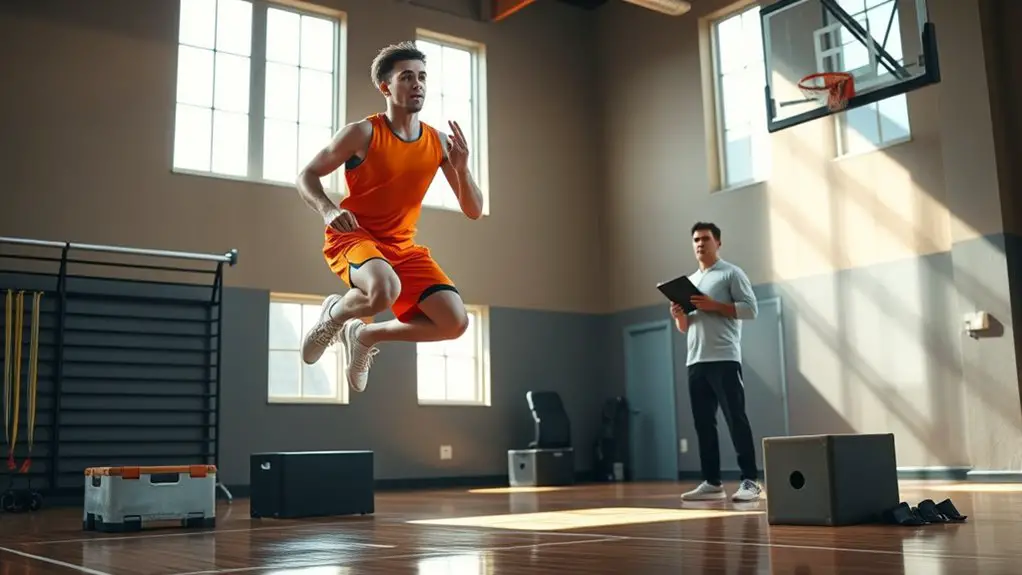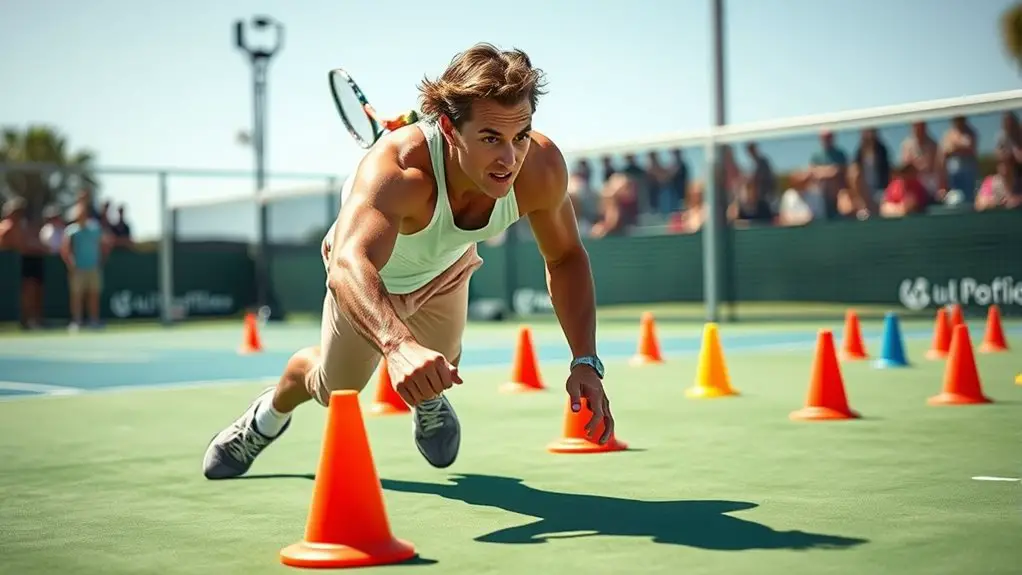To improve your hip mobility for better sports performance, focus on both stretching and strengthening exercises. Incorporate dynamic stretches like leg swings and walking lunges to warm up your muscles. Use static stretches to enhance flexibility and foam rolling to release tension. Strength exercises, such as squats and lunges, will build supporting muscles. Dedicate time to mobility drills in your training routine for lasting results. Stick around to uncover more techniques for optimizing your performance.
Understanding Hip Mobility and Its Importance in Sports
Hip mobility is vital for athletes looking to enhance their performance. When your hips move freely, you can execute powerful movements, maintain balance, and prevent injuries. Think about it: every time you sprint, jump, or change direction, your hips play a significant role. If they're tight or restricted, it can hold you back and limit your potential.
Improving hip mobility not only boosts your athletic capabilities but also allows you to express your body's natural freedom. You'll feel more agile, fluid, and ready to tackle any challenge that comes your way. Plus, better hip mobility can enhance your overall posture and body mechanics, making daily movements easier and more efficient. By prioritizing mobility training, you can unlock your full athletic potential and enjoy the freedom of unrestricted movement.
Embracing the journey to greater hip mobility is about releasing your body's potential and finding joy in movement. So, let's explore how you can cultivate this vital aspect of athletic performance and embrace your freedom to move!
Effective Stretching Techniques for Improved Hip Flexibility
To improve your hip flexibility, you'll want to incorporate a variety of stretching techniques. Dynamic stretches can warm up your muscles, while static stretches help improve overall flexibility. Don't forget about foam rolling, which can release tension and enhance your range of motion.
Dynamic Stretching Exercises
While many athletes focus on strength training, incorporating dynamic stretching exercises can greatly enhance your hip flexibility and overall performance. These movements engage your muscles while improving range of motion, setting you up for success. Here are some effective dynamic stretches you can try:
| Exercise | Description |
|---|---|
| Leg Swings | Swing one leg forward and back. |
| Walking Lunges | Lunge forward with alternating legs. |
| High Knees | Run in place, lifting knees high. |
| Butt Kicks | Jog while kicking heels to glutes. |
Static Stretching Methods
After warming up with dynamic stretching, incorporating static stretching methods can further enhance hip flexibility. These techniques focus on holding stretches for a longer duration, allowing your muscles to relax and elongate. Try the pigeon pose to target your hip rotators or the butterfly stretch for the inner thighs. Hold each position for 20-30 seconds, breathing deeply to release tension. Remember, it's important to stretch both sides to maintain balance. You'll want to listen to your body—never push too far, as that can lead to injury. By consistently engaging in these static stretches after workouts, you'll notice improved mobility and performance in your sports activities, giving you the freedom to move with greater ease and confidence.
Foam Rolling Techniques
Foam rolling is an effective technique that can greatly improve hip flexibility and overall mobility. By targeting tight muscles and fascia, you can release tension and enhance your range of motion. Start by focusing on the hip flexors, glutes, and outer thighs. Roll slowly over each area, pausing on any tight spots for 30 seconds to a minute. This'll help break up adhesions and improve blood flow. You might feel some discomfort, but that's a sign you're working out the kinks. Incorporate foam rolling into your warm-up or cool-down routine for best results. With consistent practice, you'll notice improved mobility, allowing you to move freely and perform better in your sport. Embrace the freedom that comes from enhanced hip flexibility!
Strengthening Exercises to Support Hip Mobility
To enhance your hip mobility, it's essential to incorporate strengthening exercises into your routine. Key movements, resistance band exercises, and bodyweight drills can all play an important role in supporting your hip function. By focusing on these elements, you'll not only boost your strength but also improve your overall athletic performance.
Key Strengthening Movements
While hip mobility is essential for athletic performance, strengthening the muscles around the hip joint is equally important. Incorporating key movements like squats, lunges, and deadlifts can help you build the strength needed for stability and power. Focus on variations that target different muscle groups, such as sumo squats for inner thighs and Bulgarian split squats for balance. These exercises not only enhance your strength but also promote better range of motion. Don't forget to engage your core; a strong core supports hip function and improves overall athleticism. By integrating these movements into your routine, you'll not only release greater freedom in your hips but also elevate your performance, allowing you to move freely and confidently in your sport.
Resistance Band Exercises
Incorporating resistance band exercises into your routine can further enhance hip mobility while also building strength. These bands offer a versatile way to target hip muscles without heavy weights. Start with lateral band walks, which activate your glutes and improve stability. Simply place the band around your thighs, squat slightly, and step side to side. Next, try banded hip thrusts; position the band across your hips and secure it under your feet. This exercise strengthens your glutes and increases mobility. Finally, perform external rotations by anchoring the band to a low point, holding the opposite end, and rotating your hip outward. These resistance band exercises are simple yet effective, empowering you to move with greater freedom and confidence.
Bodyweight Strength Drills
Five essential bodyweight strength drills can greatly enhance your hip mobility while building the supporting muscles required for ideal movement. Start with bodyweight squats to strengthen your quads and glutes while improving flexibility. Next, try lunges; they promote dynamic movement and engage multiple muscle groups. Incorporate hip bridges to activate your hamstrings and glutes, enhancing stability. Don't forget side leg raises, which target the hip abductors, vital for lateral movement. Finally, add deep squat holds to increase flexibility and strength in your hips. By consistently practicing these drills, you'll not only improve your hip mobility but also empower yourself to move freely and perform better in your sport. Embrace these movements for a more liberated, active lifestyle!
Dynamic Warm-Up Routines to Enhance Hip Function
To maximize your hip function and overall sports performance, incorporating dynamic warm-up routines is essential. These routines not only prepare your body for action but also promote freedom of movement. Here are three dynamic warm-ups you should consider:
- Leg Swings: Stand on one leg and swing the opposite leg forward and back, feeling your hips loosen up. This opens up your hip flexors and improves range of motion.
- Walking Lunges: Step forward into a lunge, alternating legs. This engages your hip muscles while enhancing stability and strength.
- High Knees: Jog in place while driving your knees high. This elevates your heart rate and activates your hip flexors, getting you ready for movement. Engaging in these warm-up routines can also help reduce the risk of injury during physical activities, enabling a safer practice of your sport.
Incorporating Mobility Drills Into Your Training Regimen
While many athletes focus on strength and conditioning, neglecting mobility drills can hinder your performance. Incorporating mobility drills into your training regimen is essential for releasing your body's full potential. Start by dedicating just a few minutes before and after your workouts to these exercises. Simple movements like hip circles, lunges, and deep squats can considerably enhance flexibility and range of motion.
You can also integrate dynamic stretches during your warm-ups to keep your hips loose and ready for action. Remember, consistency is key—aim for 2-3 times a week. You'll not only feel freer in your movements but also reduce the risk of injury. As you make mobility drills a habit, you'll notice improvements in your performance, whether you're sprinting, jumping, or changing direction. Additionally, enhanced core strength plays a crucial role in stabilizing your movements, ultimately leading to more efficient athletic performance. Embrace the freedom that comes with greater hip mobility, and watch your athletic abilities soar!
Tips for Maintaining Long-Term Hip Mobility
Maintaining long-term hip mobility requires consistent effort and attention, especially as you progress in your athletic career. You want that freedom of movement, right? Here are some tips to keep your hips feeling great:
Consistent effort is key to maintaining hip mobility for optimal movement in your athletic journey.
- Daily Stretching: Incorporate dynamic stretches into your daily routine. Spend just 10 minutes each day targeting your hip flexors and surrounding muscles. You'll feel more agile and less restricted.
- Strength Training: Build strength in your hips and core. Exercises like squats and lunges not only improve strength but also enhance mobility, allowing you to move freely and confidently on the field.
- Regular Mobility Work: Set aside time each week for dedicated mobility sessions. Techniques such as foam rolling and yoga can help maintain flexibility and prevent stiffness. Additionally, focusing on joint function through these practices is essential for overall athletic performance.
Frequently Asked Questions
How Often Should I Perform Hip Mobility Exercises?
You should aim to perform hip mobility exercises at least three to four times a week. Consistency's key, and incorporating them into your routine can help you feel more free and agile in your movements.
Can Poor Hip Mobility Cause Knee Pain?
Isn't it frustrating when one issue leads to another? Poor hip mobility can indeed cause knee pain, as tight hips may force your knees to compensate, creating discomfort. Prioritizing mobility can set you free from these limitations.
What Sports Benefit Most From Improved Hip Mobility?
Improved hip mobility benefits sports like running, soccer, and basketball. You'll enhance your agility, flexibility, and overall performance. When your hips move freely, you're more likely to enjoy the game and avoid injuries.
Are There Age-Related Changes in Hip Mobility?
As you age, hip mobility can stiffen like a rusty hinge. You might notice less flexibility and discomfort, so staying active and incorporating mobility exercises can help maintain that essential freedom of movement you cherish.
How Do I Know if I Have Tight Hips?
You'll know if you've got tight hips if you experience discomfort during movements like squatting or bending. Try stretching or mobility exercises; if you feel restricted, it's a sign your hips might need some attention.




